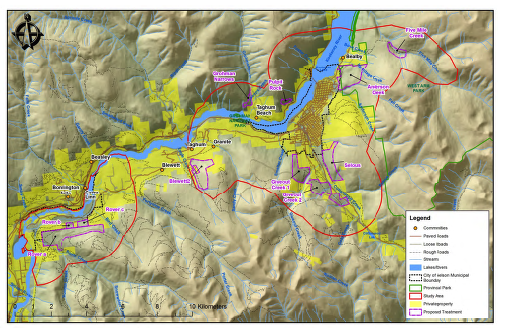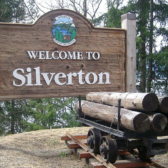City faces greater wildfire risk than Fort McMurray: consultant
Nelson could be the next Fort McMurray if the risk of wildfire in the forest surrounding the Heritage City is not reduced significantly in the near future, says a wildfire protection plan consultant.
Bruce Blackwell of B.A. Blackwell and Associates Ltd. said the city has the unenviable distinction of being in the top 10 of the most fire-prone communities in B.C. and Alberta, according to his estimation.
There is a tremendous fuel load in the area to support a wildfire — from pine beetle kill to thick forest undergrowth — that, once a major wildfire started, it would be very difficult to stop.
Blackwell had classified Fort McMurray as a low to moderate fire hazard risk — he did the plan for the city last February, three months before a forest fire exploded into the city — and the city council of Fort McMurray ignored his recommendations.
“But I think Nelson faces a far greater risk,” he told council last week during its regular meeting. “And it’s not going to be easy to evacuate people in this part of the world. In fact, it’s going to be very complicated.”
Nelson has a lot of “ignitions” throughout July and August as lightning strikes with regularity, Blackwell noted. And there is a forest fire fuel load here that is very high relative to other areas of the province.
“The risk to Nelson is significant, and it is partly due to the fact you live in a rainforest,” said John Cathro of Cathro Consulting. “The forests do grow fast but they don’t stay wet all of the time and when they do get dry it becomes a real risk.”
Blackwell and Cathro appeared before council in an administrative capacity to apprise them of what was needed and begin applying for the funding that is available to fund the work. Further consultations in January would be required to fully inform the city on what was needed to be done.
In 2015 B.A. Blackwell and Associates Ltd. and Cathro Consulting were contracted by the city to update the Community Wildfire Protection Plan.
Cathro provided an overview of the plan, highlighting the coordinated efforts between the City of Nelson, the regional district and B.C. Parks that identified areas of common interest where common wildfire risk is shared.
Of specific interest was the two-kilometre forest interface that surrounded the city. The updated CWPP provides information on the previous recommendations as well as updated risk assessments and 32 recommendations going forward.
Considering the number of recommendations, Blackwell said city council would have to set some priorities as to what it can or can’t do, and how quickly it can do it.
There is a recognition that the Forest Service is no longer capable of putting out all wildfires in all places, said Blackwell, so there are funds put in place to develop prevention strategies on a larger scale to protect communities.
But there isn’t enough to accomplish all of the work that needs to be done, so the city would have to step up and fund part of the work. He said the city needed to be on a 10-year accelerated track, not a 25-year track, to safeguard itself.
“Whatever you can do as a community to start focusing on this problem, without relying on the province, is important,” he said.
The first Community Wildfire Protection Plan for the City of Nelson was presented in 2008 and was part two of a larger plan for the regional district. The plan contained a number of recommendations that city staff carried out since 2008.
The 2008 plan identified fuel treatment areas within city boundaries that have all been addressed. The updated CWPP for the city identified a number of FireSmart and wildfire reduction initiatives including “areas of interest” just outside of Nelson that presented significant risk to the city and proposed the city work with the regional district, B.C. Parks, utilities, licensees and others to reduce the risk.
Previous fuel treatment of 107 hectares has been accomplished, but the proposed areas of interest comprise 887 ha.
This will include obtaining funding from sources such as UBCM, Strategic Wildfire Protection Initiative, Forest Enhancement Society, Columbia Basin Trust and potentially others to conduct work outside of its boundaries and into the interface areas.
Grants from UBCM, Strategic Wildfire Protection Initiative, Forest Enhancement Society, Columbia Basin Trust and potentially others could be structured differently, providing a 100 per cent grant, to a 90 per cent grant and a 10 per cent city contribution or an even split expectation.
The city would need to apply for grants as appropriate for prescription and fuel mitigation work to completed inside and outside the city boundaries but must contribute the required values towards the costs.
“In-kind contributions, are generally permitted which allow the use of staff time and resources to contribute towards the city’s portion,” read a city staff report to council.
One of the goals of the wildfire plan is to work closely with all stakeholders including industry to explore reduced fuel mitigation costs.


























